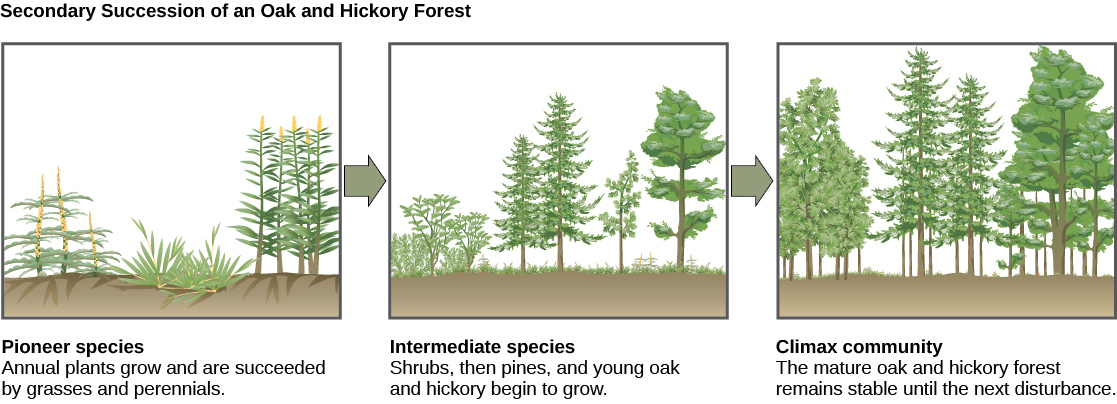5.2.5: Succession
- Page ID
- 37249
Learning Objective
Describe community structure and succession
Community Dynamics
Community dynamics are the changes in community structure and composition over time, often following environmental disturbances such as volcanoes, earthquakes, storms, fires, and climate change. Communities with a relatively constant number of species are said to be at equilibrium. The equilibrium is dynamic with species identities and relationships changing over time, but maintaining relatively constant numbers. Following a disturbance, the community may or may not return to the equilibrium state.
Succession describes the sequential appearance and disappearance of species in a community over time after a severe disturbance. In primary succession, newly exposed or newly formed rock is colonized by living organisms. In secondary succession, a part of an ecosystem is disturbed and remnants of the previous community remain. In both cases, there is a sequential change in species until a more or less permanent community develops.
Primary Succession and Pioneer Species
Primary succession occurs when new land is formed, or when the soil and all life is removed from pre-existing land. An example of the former is the eruption of volcanoes on the Big Island of Hawaii, which results in lava that flows into the ocean and continually forms new land. From this process, approximately 32 acres of land are added to the Big Island each year. An example of pre-existing soil being removed is through the activity of glaciers. The massive weight of the glacier scours the landscape down to the bedrock as the glacier moves. This removes any original soil and leaves exposed rock once the glacier melts and retreats.
In both cases, the ecosystem starts with bare rock that is devoid of life. New soil is slowly formed as weathering and other natural forces break down the rock and lead to the establishment of hearty organisms, such as lichens and some plants, which are collectively known as pioneer species (Figure \(\PageIndex{1}\) because they are the first to appear. These species help to further break down the mineral-rich rock into soil where other, less hardy but more competitive species, such as grasses, shrubs, and trees, will grow and eventually replace the pioneer species. Over time the area will reach an equilibrium state, with a set of organisms quite different from the pioneer species.

Secondary Succession
A classic example of secondary succession occurs in forests cleared by wildfire, or by clearcut logging (figure 2.2.2.c2.2.2.c). Wildfires will burn most vegetation, and unless the animals can flee the area, they are killed. Their nutrients, however, are returned to the ground in the form of ash. Thus, although the community has been dramatically altered, there is a soil ecosystem present that provides a foundation for rapid recolonization.
Before the fire, the vegetation was dominated by tall trees with access to the major plant energy resource: sunlight. Their height gave them access to sunlight while also shading the ground and other low-lying species. After the fire, though, these trees are no longer dominant. Thus, the first plants to grow back are usually annual plants followed within a few years by quickly growing and spreading grasses and other pioneer species. Due, at least in part, to changes in the environment brought on by the growth of grasses and forbs, over many years, shrubs emerge along with small trees. These organisms are called intermediate species. Eventually, over 150 years or more, the forest will reach its equilibrium point and resemble the community before the fire. This equilibrium state is referred to as the climax community, which will remain until the next disturbance. The climax community is typically characteristic of a given climate and geology. Although the community in equilibrium looks the same once it is attained, the equilibrium is a dynamic one with constant changes in abundance and sometimes species identities.



